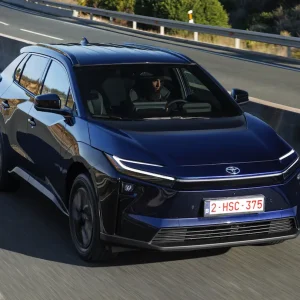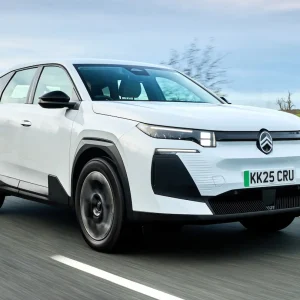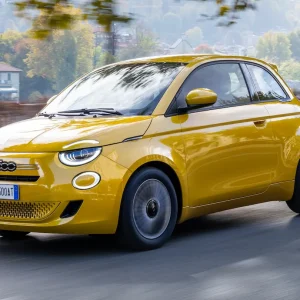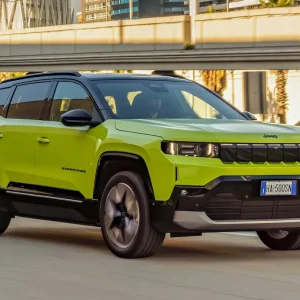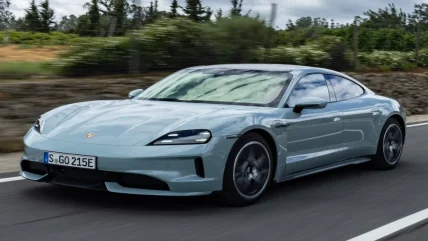
It’s not possible, surely? Has the Porsche Taycan really been around since 2019? Yep, it has indeed, which means it’s ripe for a nip and a tuck to keep it fresh in the ever-competitive world of electric cars.
The highlight of the original Taycan was its handling, for sure. Other similarly priced EVs, such as the Tesla Model S, might’ve been as quick in a straight line, but none could engage like a Taycan around corners. That included everything from the entry-level rear-wheel-drive Taycan, right up to the Turbo S. Which, by the way, is no longer the range-topper.
That’s now the Turbo GT. It knocks the jeepers-o-meter farther into to the red zone with these stats: up to 1034hp, 0-62mph in 2.2sec (if you have the lightweight Weissach Package), and 190mph flat out. And still 2% BIK, just like the rest of the range, but the P11D of £186,300 suggests you won’t see as many of these as lesser Taycans.
Perhaps the Achilles heel of the previous Taycan range was, well, range. The best it could officially manage was just over 300 miles. But now thanks to more battery capacity and improved battery software, better regenerative braking performance and reduced weight, the entry-level Taycan (BIK £86,500) can now officially manage 367 miles.
If you add the Performance Battery Plus, which takes the battery size from 89kWh (gross) to 105kWh, then the range is a Tesla-beating 421 miles. The only premium-badge offering that betters that is the Mercedes EQS 450+ at 441 miles. Even the popular 4S can manage 401
miles with the optional 105kWh battery, with peak power now up to 598hp and 0-62mph down to 3.7 seconds. It’s still the pick of the range for its blend of range and pace.
Every version has more range and more performance, though, along with a host of other improvements. Peak charging speeds rise from 270kW to 320kW, and with improved battery management, a 10-80% charge takes as little as 18 minutes. Even with a 150kW charger you can get that boost in around 30 minutes.
All versions now come with adaptive air suspension, while Porsche Active Suspension is optional. This can tilt the car into bends – like a motorbike – to reduce sideways forces on occupants, or keep the car cornering flat to increase grip. It even lifts the Taycan up by 55mm when you open a door to make it easier to get in and out.
Other new trinkets include the optional adaptive HD Matrix LED headlights (regular Matrix lights are standard), which have a range of 600 metres and contain 32,000 pixels to shape their light more accurately. Perhaps the part that’s changed the least is the looks – the tweaks front and rear really are subtle, as are the improvements to the driving experience.
That’s not a criticism, by the way. We spent most of the time driving the 4S on road, and, as before, there is plenty to savour. The steering is still superb, with welcome heft and confidence-building accuracy. And when you push the limits of grip you can only marvel at how much speed the 4S can carry through turns. It continues to be the most engaging EV to drive.
Wind noise is hushed and you can’t hear much from the motors (the four-wheel-drive 4S has motors front and rear). It comes with 19in alloys, but our test car had optional 21s, which generate a noticeable amount of road noise over coarse surfaces. Even so, the ride, with the Active Suspension option ticked, is so supple and far better-controlled than the floaty Mercedes EQE.
It also has all the performance you could reasonably need. Yes, there are faster Taycans – faster rivals, too – but the instant punch off the line and ability to romp to 70mph is astounding.
It’s still beautifully made inside, retains the previous model’s excellent driving position and its ability to seat four adults. The on-board tech now includes Android Auto (to go with Carplay) and a new 15kW wireless phone charger with cooled charging pad. The sheer number of screens inside remains slightly bewildering – a few more physical buttons would help usability – but otherwise, the revised Taycan is tough to fault.
Porsche Taycan 4S (Performance Battery Plus)
P11D: £100,196
Residual value: 37%
Depreciation: £62,746
Fuel: N/A
Service, maintenance and repair: £4,082
Cost per mile: N/A
Range: 401 miles
CO2 (BIK %): 0g/km (2%)
BIK 20/40% a month: £35/£71
Luggage capacity: 84 litres (front);
407 litres (rear)
Battery size/power: 105kWh (gross)/ 598hp (with overboost)

